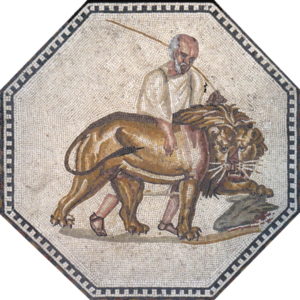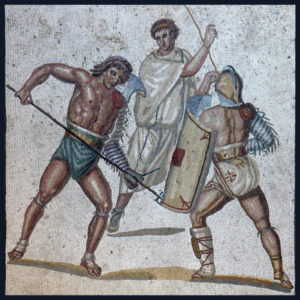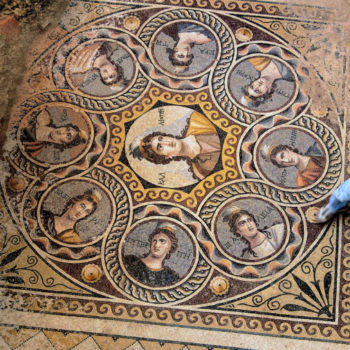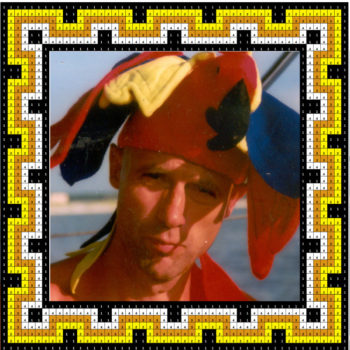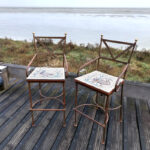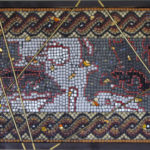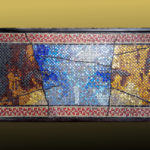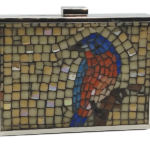Visiting the Nennig mosaic was my first goal in a trip I took in June 2019 to Northeastern France and Western Germany. I give practical information about this trip (itinerary, accommodations, costs…) in my previous post “Mosaics of Northeastern Gaul”
NENNIG
2000 years ago the Moselle valley became part of the Roman Empire. Rome settled armies there to prevent invasion by the German tribes. During this time high dignitaries of the Empire built sublime villas on the hillsides of the Moselle. Over the next four centuries, the Romans would leave an indelible mark on this region and its culture.
Nennig is a small village situated on the river Moselle, opposite Remich, Luxembourg and a few kilometers from France. 20 centuries ago it was on the road joining the important military and administrative towns of Augusta Treverorum and Dividorum. (Present day Treves, Germany and Metz, France)

THE ROMAN VILLA
The Villa was built in the 3rd century. Facing West, it enjoys a panoramic view of the Moselle river’s vineyards.
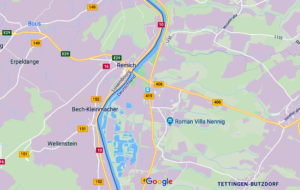
You can park in front of the entrance to the site.
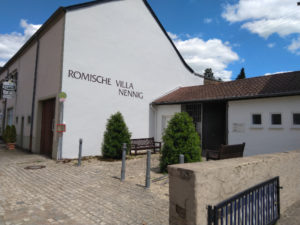
Excavations conducted between 1866 an 1876 revealed the foundations of an imposing Villa.
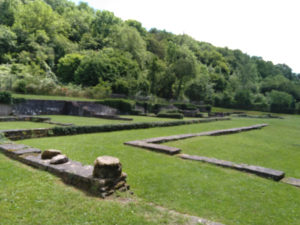
Part of the complex is still under modern houses and their gardens.
In front of the Atrium and its mosaic, a two storied colonnaded building was flanked by 2 three storied towers, themselves flanked by two temple-shaped structures.

The Nennig mosaic
The Nennig mosaic covered the floor of the villa’s Atrium. It is protected by an elevated building allowing to watch if from above. It covers an area of about 160 m2 (1700 sq ft). The Nennig mosaic is claimed by local authorities to be the largest one discovered North of the Alps.
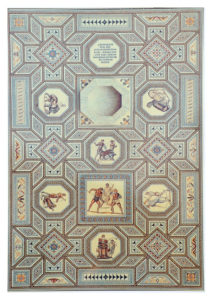
It comprises a total of 9 medallions : eight octagonal and one square one. The top octagonal medallion was missing when the mosaic was excavated. it is now filed with a plaque commemorating the excavation campaign. Below it, a bigger octagonal space by a marble fountain.
The other 7 medallions represent circus games scenes. Elaborate geometrical patterns fill up the space between each medallion and border the mosaic.
The Medallions of the Nennig Mosaic
The Musicians
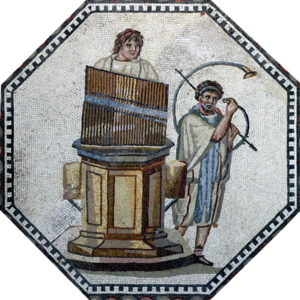
Beginning and end of the Roman games were often accompanied by music. This octagonal medallion depicts an organist playing a water organ and a curved horn player.
Venatio : Panther
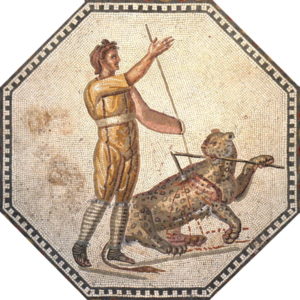
Venationes (beast hunts) often opened the circus games. This octagonal medallion depicts a Javelin armed venator having wounded a panther. His javelin bent in 2 halves in the same manner a pilum (war javelin) would bend once thrown into an enemy’s shield. This would render this shield more difficult to carry. In this particular case, the javelin is preventing the panther to fight.
Venatio : Tiger vs Onager
An other kind of venatio consisted of pitting animals against other animals.
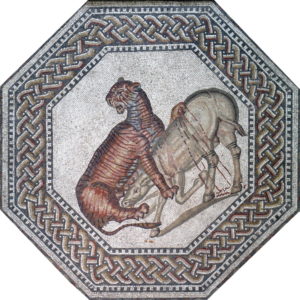
This octagonal medallion depicts a tiger attacking a wild ass. Although the ass is wounded it is possible the tiger was trained to not kill but only subjugate him. Wild animals and gladiators were expensive performers. Their owners or agents invested lots of money in their training and although accidents would at time happen, referees and animal handlers were present on the floor to prevent them.
Lion escorted by its keeper
Octagonal medallion depicting a lion escorted by his aged keeper.
Not all the animals used in the circus games were wild. Just like a hawk answers the commands of its falconeer, this lion used to hunt other animals is trained to answer his keeper’s orders.
Bear against three venatores
Octagonal medallion depicting two venatores trying to rescue another one from a bear.
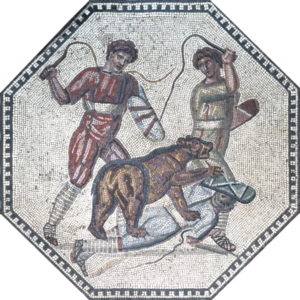
In the center panel of the Nennig mosaic, a bear is mauling a venator he has thrown to the ground. (can’t trust them bears !) Two other venatores are trying to get his attention away with their whips. The fact they are not using lethal force against him is a good indication of its commercial value to the gladiatorial industry.
Gladiators fighting with blunt weapons
Octagonal medallion depicting two combatants attacking one another with sticks and whips.
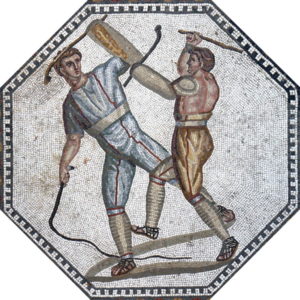
The gladiatorial contest usually included a prelude during which the performers fought each other with blunt or light weight weapons. Although some gladiators were slaves, others were freemen on contract with privately owned teams. It was nobody’s interest to see these highly and expensively trained performers killed in combat.
Retiarius vs Secutor
Square medallion depicting a Retiarus armed with trident and dagger fighting against a Secutor.
This is the highest type of fight. The biggest medallion of the Nennig mosaic, it was to be seen by the guest entering the Atrium. Those gladiators are armed with actual lethal weapons. They are supervised by a referee (Summa rudis) whose job is to make sure the rules are respected and if at all possible prevent the occurrence of lethal wounds. Accidents would still happen…
Geometric Patterns
In a next article I will post pictures of the geometric patterns of the Nennig mosaic.
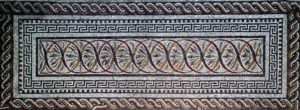
Practical information
Opening hours:
April – September: Tuesday to Sunday 8:30 a.m. – 12 noon and 1 – 6 p.m.
October, November and March: Tuesday to Sunday 9 – 11:30 a.m. and 1 – 4:30 p.m.
Closed from December to February and on Monday
Address : Römerstraße 11, 66706 Perl-Nennig, tel. 49 68 66 13 29
Entrance fee : Euro 1.50 (June 2019)

